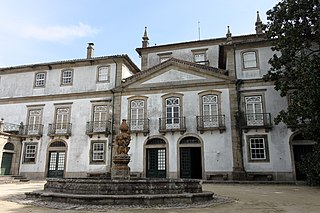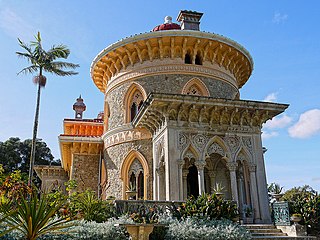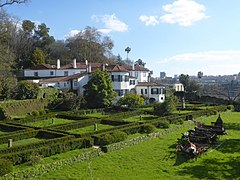
The Belém Palace, formally the National Palace of Belém,, is the current official residence of the President of the Portuguese Republic, the head of state of Portugal. Located in the Belém District of Lisbon, the palace's main façade fronts the Praça Afonso de Albuquerque, facing the Tagus River. A former residence of the Portuguese Royal Family, the Belém Palace complex is made up of various buildings, wings, courtyards, and gardens, built variously from the 18th to 21st centuries.

Vila do Porto is the single municipality, the name of the main town and one of the civil parishes on the island of Santa Maria, in the Portuguese archipelago of Azores. Its nearest neighbor, administratively, is the municipality of Povoação on the southern coast of São Miguel, and it is physically southwest of the islets of the Formigas. The population in 2011 was 5,552, in an area of 96.89 km².

Angra do Heroísmo, or simply Angra, is a city and municipality on Terceira Island, Portugal, and one of the three capital cities of the Azores. Founded in 1478, Angra was historically the most important city in the Azores, as seat of the Bishop of the Azores, government entities, and having previously served as the capital city of Portugal during the Liberal Wars. The population in 2011 was 35,402, in an area of 239.00 km². It was classified as a World Heritage site by UNESCO in 1983.

Angústias is one of the three freguesia that comprise the urban area of the city of Horta, on the island of Faial in the Portuguese archipelago of the Azores. This is an economically active, densely populated area. The population in 2011 was 2,418, in an area of 3.79 km2. Due to its commercial nature, the parish is one of the island's primary destinations for tourism, due to the concentration of historical sights and shopping. It contains the localities Caminho do Meio, Courelas, Pasteleiro, Port Pim, Termo da Igreja and Vigia.

Cartaxo is a municipality in the district of Santarém in continental Portugal. The population in 2011 was 24,462, in an area of 158.17 km². The urbanized centre of Cartaxo had a population of 9,507 in 2001.

Serralves is a cultural institution located in Porto, Portugal, and one of the most important institutions worldwide, ranking in the list of most-visited art museums in the world. It includes a Contemporary Art Museum, a Park and a Villa, each one an example of contemporary architecture, Modernism, and Art Deco architecture. The Museum, designed by Álvaro Siza Vieira, is now the second most visited museum in Portugal and one of the most relevant in the contemporary art circuit in Europe.

The Residence of Biscainhos, is a former-signeurial residence located in civil parish of Braga, in the municipality of Braga, in northern Portuguese district of Braga.

The Casa dos Bicos is a historical house in the civil parish of Santa Maria Maior, in the Portuguese municipality of Lisbon. The house, built in the early 16th century in the Alfama neighbourhood, has a curious façade of spikes, influenced by Italian Renaissance palaces and Portuguese Manueline styles. It survived the disastrous 1755 Lisbon earthquake that destroyed much of the city, but over time was abandoned as a residence and used as a warehouse. After a 20th-century renovation, it became the headquarters of the José Saramago Foundation and a location of the Museum of Lisbon.

The Residence of Águas Férreas is a residence in the civil parish of Cedofeita, Santo Ildefonso, Sé, Miragaia, São Nicolau e Vitória, in the municipality of Porto, in the Portuguese district of Porto.

The Residence Rua D. Hugo is a residence and archaeological site in the civil parish of Cedofeita, Santo Ildefonso, Sé, Miragaia, São Nicolau e Vitória, in the municipality of Porto, in the Portuguese district of Porto.

The Museum-Residence of Guerra Junqueiro is a former-residence and museum located in the civil parish of Cedofeita, Santo Ildefonso, Sé, Miragaia, São Nicolau e Vitória, in the Portuguese north, municipality of Porto, classified as a Imóvel de Interesse Público.

Avanca is a civil parish in the municipality of Estarreja, in the central subregion of Baixo Vouga. The population in 2011 was 6,189, in an area of 21.07 km2.

The Tower of Pedro-Sem is a medieval fortification situated in the civil parish of Lordelo do Ouro e Massarelos, that protected the northern Portuguese city of Porto.

The Palace of the Carrancas is a former-residence in the civil parish of Cedofeita, Santo Ildefonso, Sé, Miragaia, São Nicolau e Vitória, in the northern Portuguese city of Porto. It houses the Soares dos Reis National Museum.

The Residence of the Maias, is a 16th century building situated in the Portugueses civil parish of Cedofeita, Santo Ildefonso, Sé, Miragaia, São Nicolau e Vitória, municipality of Porto, the district of the same name.

The Fountain of Passeio Alegre is a fountain located in civil parish of Aldoar, Foz do Douro e Nevogilde, municipality of Porto in northern Portugal.

The Curutelo Castle is a well-preserved medieval castle located in the civil parish of Ardegão, Freixo e Mato, in the municipality of Ponte de Lima, Portuguese Viana do Castelo.

The architecture of Póvoa de Varzim, in Portugal, demonstrates a broad variety of architectural styles over its thousand years of history. 11th-century Romanesque, 16th-century Mannerism, 18th-century Baroque, late 18th-century neoclassicism, early 20th-century Portuguese modernism and late 20th- to early 21st-century contemporary architectural styles and more are all represented in Póvoa de Varzim. As a whole it represents a rich eclectic tradition and innovation shaped by the people, their beliefs and economy.
The Arcaheological site of Quinta dos Patudos is an archaeological site in the civil parish of Alpiarça, in the municipality of the same name in the Portuguese district of Santarém. Sometimes referred to as the "castle" of Alpiarça, it is part of an archeological station within the Quinta dos Patudos, that includes the Castle of Alpiarça, Cabeço da Bruxinha, Necropolis of Tanchoal and the Necropolis of Meijão.

The Portuguese Riviera is the affluent coastal region to the west of Lisbon, Portugal, centered on the coastal cities of Cascais, Estoril, and Sintra. It is coterminous with the Estoril Coast and occasionally known as the Costa do Sol. The region is internationally known as a luxury destination for its history as a home of the wealthy, the famous, and European royalty. Both Cascais and Sintra consistently rank among the richest municipalities in Portugal.




















